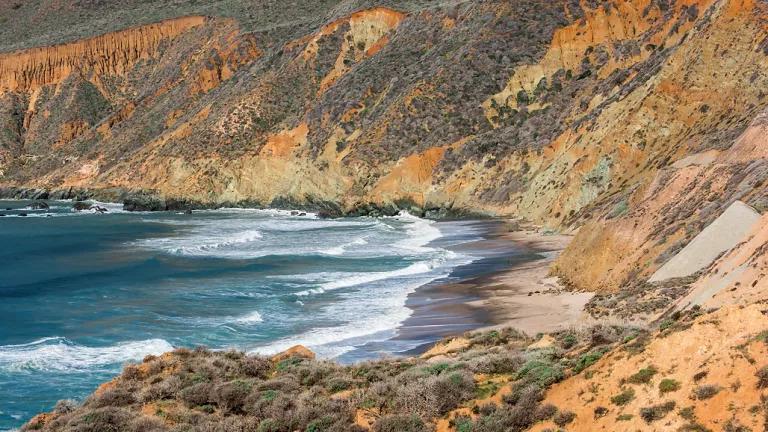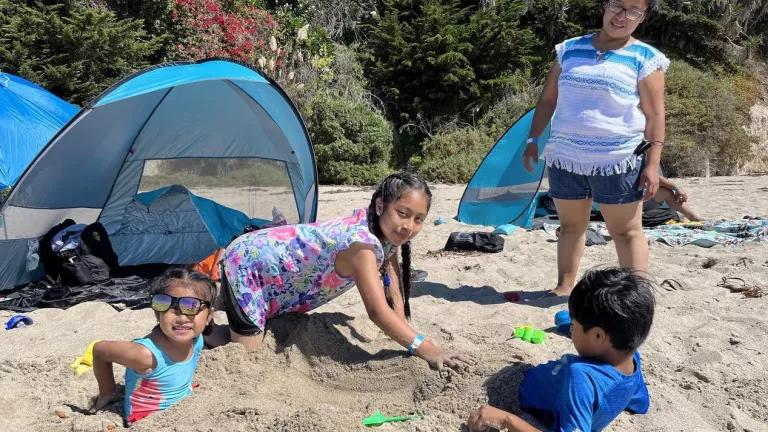MPAs Work, Let’s Make Them Work for Everyone
If California is to remain a leader in marine protection, we as advocates, scientists, and state agencies must adapt our perspectives on who values our ocean and its resources.

Pt. Vicente lighthouse and no-take State Marine Conservation Area
John Watson via Flickr, CC BY-NC 4.0
Last month, the California Department of Fish and Wildlife (CDFW) released the seminal Report for the 2022 Decadal Management Review (DMR) of the state’s marine protected area (MPA) network. This Report is an incredible feat because it summarizes ten years of information about California’s MPA network and puts forth adaptive management recommendations. Monitoring and adaptive management are the gold standard of ocean conservation, meaning that the results of the DMR have implications for the health of California’s ocean and for effective MPA management globally. The DMR Report reflects CDFW’s impressive work to navigate and synthesize the vast amounts of information provided by scientists, Tribes, partners, state agencies and an array of stakeholders. The Report shows that there are notable wins for California’s ocean health and clear progress towards Tribal stewardship. However, the array of stakeholders represented was limited, reinforcing a common bias about who has a say in ocean protection and who it benefits.
Key Takeaways from the Decadal Management Review Report
California is hailed as a global leader in marine and biodiversity protection for creating its inaugural MPA network in 2012, and had the incredible foresight to make a $20M investment in monitoring and evaluating its effectiveness. Ten years later, this review process is critical to understanding the ecosystem and human impacts of the network and to adapt it to better serve people and planet. MPAs are the best tool we have to stem biodiversity loss and are a key solution to meet future ocean challenges like climate change and industrial use. What we learn from the DMR sets California’s path forward and offers a new opportunity to set a global precedent for adaptive management in the face of emerging threats, while equitably balancing the dimensions of use and access. The key takeaways that can support better MPA management here and elsewhere are:
- Learned Lessons on Tribal Engagement - The state has made considerable progress in acknowledging and understanding California Native Tribes’ connection to and stewardship of nature. Through the DMR Report, CDFW offers a clear commitment to advancing Tribal engagement and stewardship in MPA management. Though just shy of including a formal apology to Tribal communities, the prioritization of Tribal perspectives in the DMR process and the commitment to meaningful inclusion is both significant and commendable progress.
- MPAs Work - Overall, California’s MPAs host healthier ecosystems and are supporting biodiversity. The data weren’t uniformly positive, which is to be expected given the state’s expansive coastline and factors that influence MPA performance—such as compliance with regulations, marine heatwaves and the varying ages of the MPAs themselves. However, one clear takeaway is that there were more fish, bigger fish, and older fish inside the no-take MPAs studied. And, some MPAs showed ecological resilience, bouncing back from the disruptive marine heat wave of 2014-2016 faster than sites outside of MPAs.
- The MPA Network Needs More Time and Stronger Protections - Ecosystem recovery takes time. Many species found along the California coast reach reproductive maturity in time spans longer than the decade of reprieve from extractive use we’ve given them so far. Compounded with emerging threats from climate change and new industrial ocean uses, fully and highly protected areas within the MPA network (like our State Marine Reserves) are more important than ever to “insuring” the biodiversity of our ocean for decades to come.
The information gathered and presented throughout the Report could help us build on our current ocean protection successes. Continued monitoring and review is essential, but there are mistakes to correct as we look ahead to the next decade.
MPA Management Should Reflect California’s Commitment to Equity
When California’s MPA network was implemented, the state took steps to create an open, stakeholder-driven process, and though well-intentioned and groundbreaking, it was not perfect or truly inclusive. Now, with a more robust and mainstream body of knowledge on equity practices, the state must strive for a truly equitable and inclusive decision-making process.
Unfortunately, the DMR Report raises concerns that the state views the social impacts of MPAs—its benefits and its costs—through the narrow lens of the commercial and recreational fishing industries. Appendix A of the DMR Report, which lists the stakeholder recommendations CDFW received in preparation for the review, offers an example of this shortfall. The interests of fishing industry groups are included in the Justice, Equity, Diversity and Inclusion (JEDI) section of the Appendix. This classification is incorrect. Placing the requests of a privileged few alongside recommendations to enhance opportunity for the marginalized, undermines the needs of truly underserved communities. This characterization coming from a state agency sets a dangerous precedent, with potential to weaken the work of environmental justice advocates across the state and country. Fishing interest groups have already attempted to equate concerns around equitable access for underserved communities with their own interests; by including fishermen’s recommendations in the JEDI section of the Report, CDFW appears to legitimize this false notion. CDFW should issue a correction to this error in the Report.
The DMR process has been opaque, even to those tracking it closely, and likely much more so for those who may wish to engage and are seeking an entry point. If the state intends for the DMR to be a public process, moments for public input and the scope of opportunity for public comment must be made clear, and information on every step should be shared widely. CDFW’s own JEDI Action Plan, which makes commitments to advancing Justice, Equity, Diversity and Inclusion internally through workforce and hiring practices, concludes with, “The work that we do matters, and it’s our job to ensure a seat at the table for everyone.” Ensuring a seat is the first step and should be followed with clearly defined processes, adequate outreach, and inclusive language and spaces. The DMR Report was released to a limited email list demonstrating a need to expand its narrow view of their stakeholders. The Department must earnestly commit to diverse, inclusive and robust engagement—either directly, through creative partnerships, or both—for any upcoming moments in the DMR process or we risk meaningful advancements in both ecosystem health and equitable access to our ocean and its resources for all Californians.
MPAs Are for Everyone, Despite Focus on Fish
CDFW is the agency responsible for enforcing state fisheries regulations, so it stands to reason that they will also help enforce our MPA network given that direct violations will come from those participating in fishing. This does not, however, mean that MPAs exist solely to serve fisheries. More than half of all Californians visit the ocean at least once each year to enjoy nature and recreate. Our MPA network adds value to the lives of all people across this state—future input and monitoring efforts must reflect this fact.
An example of this fisheries-centric view is that the key indicator for most long-term monitoring studies in various habitats was fish. Though insightful, this focus precludes the intrinsic value of other marine life that comprise an ecosystem and reinforces the misconception that MPAs are a fishery management tool. Continued monitoring, as well as our general scientific understanding of MPAs would benefit from a more representative approach to study across the ecosystem rather than focusing on species of commercial interest.
Human dimension studies were also skewed toward fishing interests and presented throughout the Report with no acknowledgement of the biases often prevalent in focus group studies and survey sampling methods. These types of studies are difficult to design and responses are hard to gather. The integrity of the information presented on the human dimensions of the MPA network, and the decision-making that results from these data, rely on a clear and stated understanding of where the knowledge gaps lie. Even if there were limited resources for more robust human dimension surveys, presenting the findings of biased samplings as representative of an entire sector is misleading; these types of information gaps should be acknowledged throughout the Report.
Moving forward, we—as advocates, environmental organizations, scientists and agencies like CDFW—must recognize the true scope of people impacted by our work, and meaningfully include and integrate the perspectives of all who use and enjoy California’s ocean, including our MPA network. The DMR process is an opportunity to strengthen the MPA network using the best science. But, if California is to remain a global leader in marine protection, adaptive management under the DMR must also include adapting perspectives on who values our ocean and its resources. It’s for everyone—the ocean, and especially the amazing places we choose to protect.



